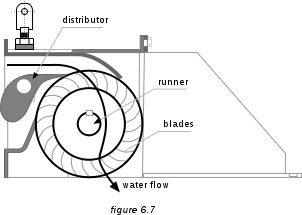Impulse Turbines
Impulse turbines are more effective in high head, low flow situations, where there is large potential energy such as in dams, tidal barrages, ,dynamic tidal power, and over topping devices. The buckets on the turbine catch falling water and rotate. They are designed so that there is minimal to no suction in the buckets and the water is able to flow out freely, allowing smoother rotation about the crank shaft. Impulse turbines discharge to atmospheric pressure. For operation at atmospheric pressure, the runner must be above maximum tailwater.
Pelton
Pelton turbines utilize water jets. An inlet nozzle builds up water pressure and then fires a stream of water at a bucket on the turbine. This is the force behind the rotational motion. The distance between the nozzle and the bucket wheel vary based on the power demand. As the distance between the spear head and inlet nozzle increases, so does the flow rate of the water. Thus, in times of high demand, this distance is increased, and so too is production.
=>
(Taken from http://formulas.tutorvista.com/physics/flow-rate-formula.html
Where C is the capacity of the water, and d is the distance it is traveling.
A Pelton turbine and water jet can be seen below.

http://www.learnengineering.org/2013/08/pelton-turbine-wheel-hydraulic-turbine.html

http://hydrover.co.uk/
Cross-Flow
Cross flow turbines are cylindrically shaped, with an outer ring and open space in the middle. With this design, the water falls off of the blades and through the open middle section to strike the blades of the turbine again. Thus, these turbines have a force applied twice for a given quantity of water. A guide vane is used to control the amount of water flowing to the runner. This turbine is less optimized for higher head than the Pelton turbine, but works well with higher flows.

http://www.fundamentalform.com/html/other_turbines.html